Wednesday 29 December 2010
Sunday 12 December 2010
Inks and paints...
...And a textured version, because the watercolour didn't live up to my hopes ;P.
Monday 29 November 2010
The Test
Sunday 21 November 2010
Morgana & Lucy: watercolour
Sunday 14 November 2010
In which I try my hand at watercolour again...
NB: I have no idea why the "back cover" image has a green hue when you enlarge it. It seems like Flickr and Photobucket do something to my colours!
ETA: Fixed! It was a CMYK image. Screens don't like that...
Saturday 6 November 2010
Pencil sketch: Kundry

Obviously, I like Kundry an awful lot :).
Monday 1 November 2010
Pencil sketch: Arthur

Clearly, when I say I want a simpler style and more stylised, I am not talking about my characters' hair. A few simple lines simply will not do in that department ;-). I am so doomed.
Monday 18 October 2010
Another small pencil sketch
Sunday 10 October 2010
A small colour pencil sketch


I don't know if it is at all obvious, but I am trying out for a slightly different style - a more stylised one. I have tried to draw a little more realistically after having been told that one glance at my drawings suggests that my story is targeted towards children. But this increased realism, combined with my inks, doesn't please me at all. The story I have in mind is more poetic and expressive and dreamy than realistic. Sharp inks and attempts at realism don't suit it. So now I'm looking for a simpler drawing style, pencils instead of inks, and light touches of colour (I'm thinking watercolour, possibly with some colour pencils). This will take some experiment - I need to find out whether I can get the sort of effect that I am looking for, and whether the idea is at all realistic. I will keep you posted :-).
Saturday 18 September 2010
Gawain Project: The Sword of Kings 5-11
- Bernard Cornwell, The Winter King (1995)

Constructive criticism is, as always, very welcome. I am thinking of drawing, inking and rendering this episode first by way of test, because I am not quite happy with the way my first inked TDH page looks, and since SoK is a short story, I can afford to experiment a little with it. But it would be great if I could get the layout right first.
In other news: I hope not to keep you waiting too long for the continuation of the story. I have been going over my general plot pages and noticed a) how much has changed since I typed them out a few months ago and b) the story is shaping up and making sense. The beginning needs some sorting out and I need to find my Schwung to get it going - but I think I am getting there (finally).
On to the comic, then!
What went before
Queen Ygraine has disappeared and Uther is desperate to get her back. He searches the land frantically but can find no trace of his wife. Having heard that Merlin currently resides in the forest of Cit Coit Caledon, he travels there to beg the wizard for help. He is met by the Giant Herdsman instead...


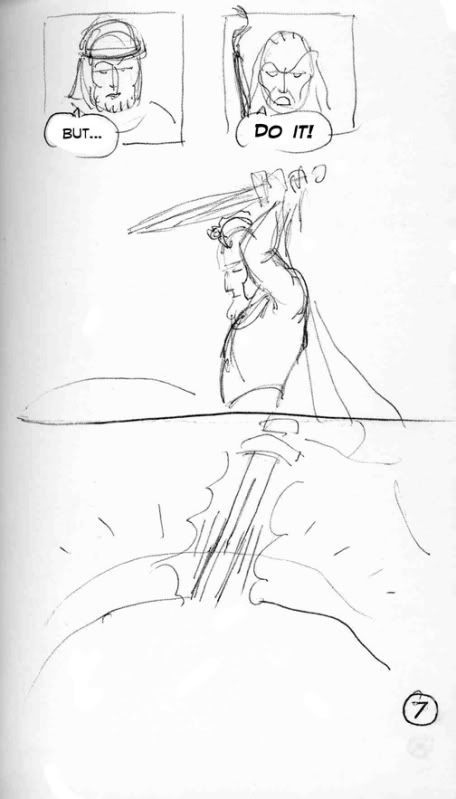
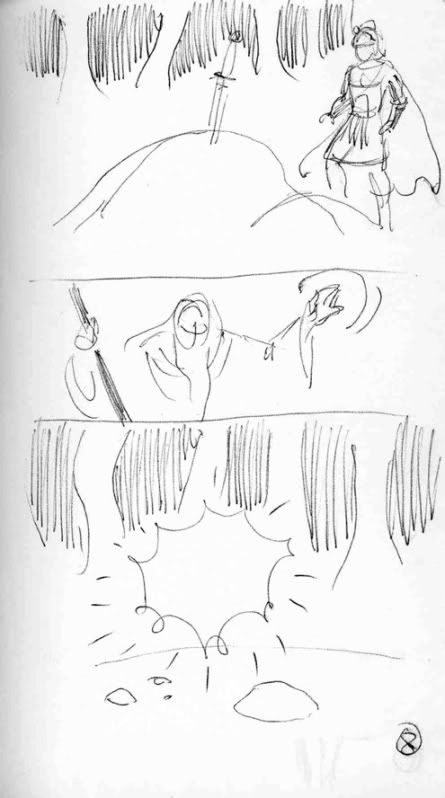
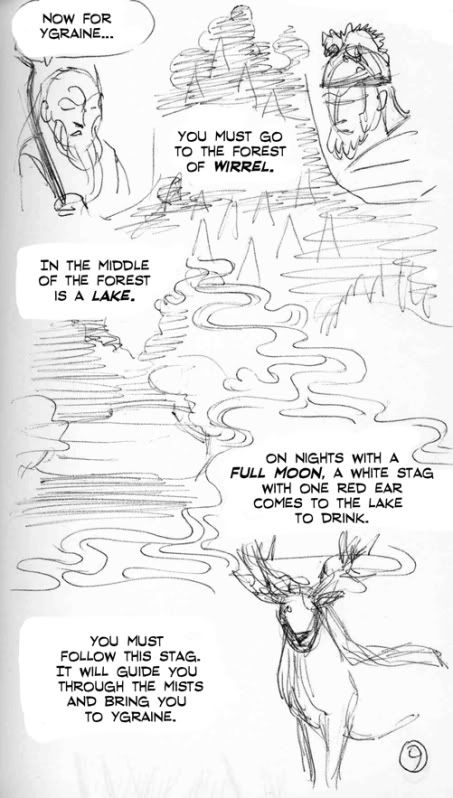
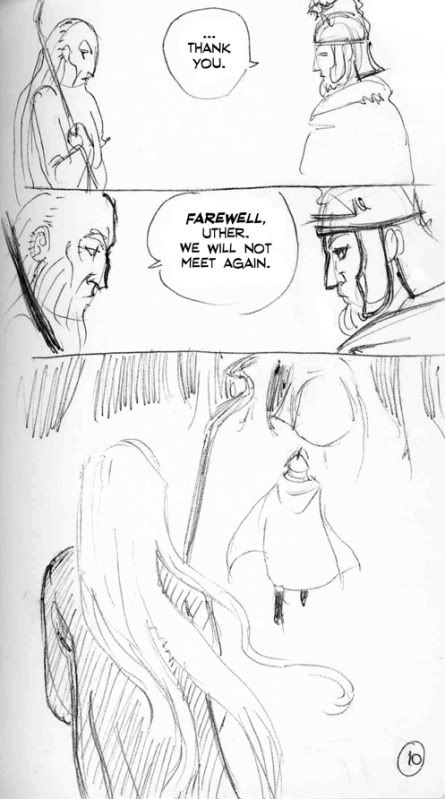
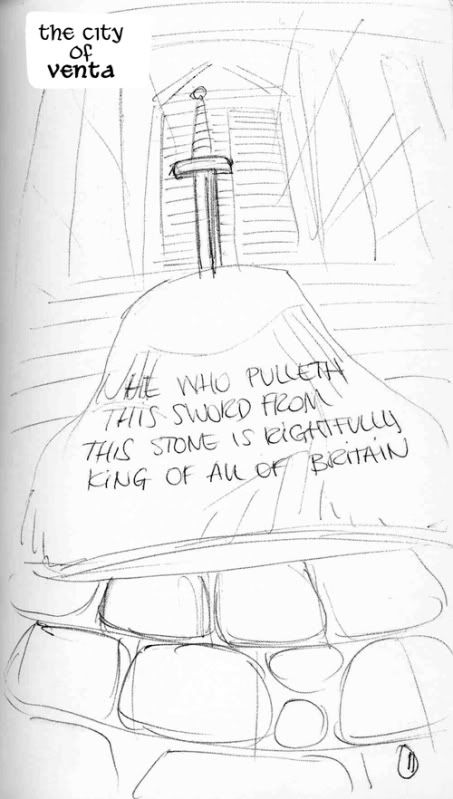
Hope you enjoyed it a little, even if it was not much more than a bridge episode. Thank you very much for reading!
♥
Saturday 11 September 2010
Gawain Project: The Sword of Kings 1-4
- Adolf Muschg, Der rote Ritter (1993)

You know the drill: constructive criticism is most welcome. I am very grateful for it and will certainly take it into account for the final version.
As per usual, I am posting layouts that I have been drawn on the train. They are by no means finished. The SoK drafts have been drawn with a ballpoint pen in a tiny notebook - less than half the size of the notebooks I used for TDH. That wasn't planned. I had been drafting in my usual notebooks, but I got stuck twice on the same plot element that I could not iron out. In the end, I simply didn't take my comic notebooks and pens with me anymore. But whaddayaknow, one day during a train ride I suddenly figured out how to go about it. The only notebook I had on me was tiny, but I could not possibly wait until I got home to write everything down.
The greatest drawback of the small notebook is that my handwriting is necessarily tiny, and therefore mostly illegible. So to make the layouts readable, I had to letter them digitally. The result looks very odd: you get sketchy drawings combined with neat computer lettering. I'm aware of how incongruent that looks, but I didn't have much of a choice :).
Now, on to the comic!
What went before
In The Darkest Hour, you could read how Uther Pendragon, High King of Britain, fell in love with another man's wife. He makes war on Gorlois of Cornwall and, with the help of the sorcerer Merlin, introduces himself into the castle where Lady Ygraine resides with her two daughters, Morgause and Morgana. Gorlois dies in battle and Ygraine cannot escape marrying Uther, whom she loathes. She bears the High King a son, but the child is given to Merlin as payment for his past services. Morgause and Morgana are given in marriage to King Lot and King Uriens, whose support Uther needs in his military efforts against the raiding Saxons. Then, finally, Ygraine finds someone who will help her take revenge: the mysterious sorcerer Klingsor. And so one night Uther wakes up to find his Queen gone...
(Need to re-read? You can do so here.)
This is how the story continues.

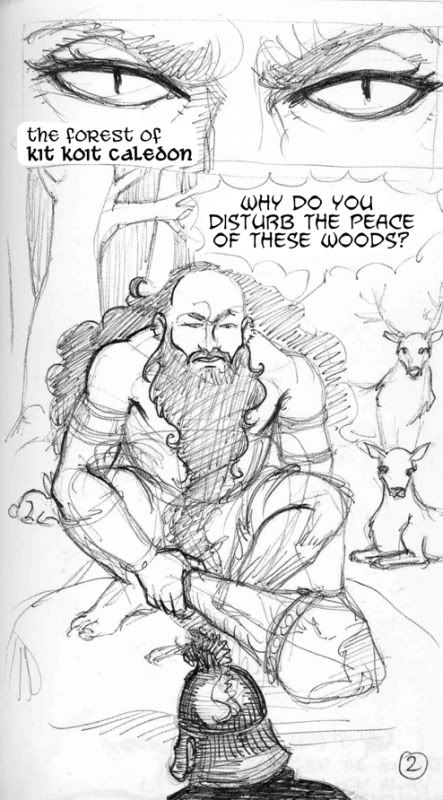
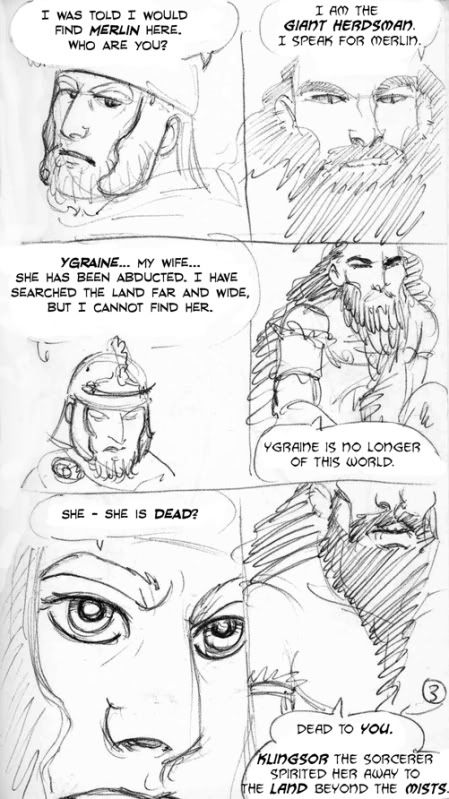

Friday 10 September 2010
Saturday 4 September 2010
The Arthurian Review, Issue 5
A few months ago, I received a package in the mail. It came all the way from the States and contained a 104-year-old book – a 1906 reprint of an Edwardian bestseller. My friend Karina's
Warwick Deeping
It had been a while since I had last read a baroque Victorian novel, and it seems that I had all but forgotten what it is like. Reading the first few pages of Deeping’s prose was a little like receiving a blow to the head. I was dizzy with the overwrought imagery. Here is a taste:
Mr Deeping (1877-1950), it is clear, likes his Aesthetes. He harnesses the worst affectations and most artificial phrasing of Wilde and Swinburne to write a romance novel. He adds positively lethal doses of alliteration and superfluous adjectives to the mix. In fact, his writing reminds me painfully of my own prose style :P. To do myself justice, I don’t insist on using “panier” when I could write “basket”, or “potage” instead of “soup”. Deeping does. As soon as I got used to it, I actually found his pedantry funny and went along with it.
Uther & Igraine is pure historical romance. When I say “historical”, I mean it in the widest possible sense. The story is set in what looks like post-Roman Britain, but the author adds all sorts of elements that evoke chivalry and courtly love and do not match the timeframe at all. Everything in this novel serves the romance. Characterisation, historicity and background: they are all (mostly cardboard) props to decorate the stage on which the Passionate and True Love of Uther and Igraine is shown. But if you can accept the novel for what it is, it is quite an enjoyable read, and much less silly than many of its modern counterparts.
“The true love of Uther and Igraine”? You heard it right.
My little summary might lead you to assume that Igraine spends the entire novel playing the part of damsel in distress. If it is true that she has to suffer violence, trickery and death threats, it should nevertheless be mentioned that she is also a brave girl with a sharp tongue who is not content to let other people decide her fate. She fires arrows at Saxons, lies and tricks, jousts if she has to – no, she is no wilting lily. Of course she becomes “as a child” when Pelleas is near, and she goes insane at one point, as Victorian conventions demand, but in general she is rather more emancipated than her sisters in the pseudo-feminist Arthurian novels of the 1990s. Take that, Rosalind Miles!
Should you feel like reading this cute, quirky little romance, I am happy to report that it is widely available in digital form on the Internet.
On the Gawain-o-meter:
Zero! There is no trace of Gawain, which is not surprising seeing as Igraine is very young and has no children yet. If there is neither a Morgause nor an Anna, there is not going to be a Gawain either. I have no idea how Deeping envisions Arthur’s family tree.
To prove how much fun I had reading this book, I doodled three characters while on the train. Please note that Morgan is not Morgan le Fay – she is Morgan la Blanche, who does not seem to have a counterpart in the source legend (or not that I can see).

Friday 27 August 2010
The Arthurian Review, Issue 4
Merlin Season One
Merlin Season Two
Merlin features many familiar characters from Arthurian legend, but places them in a kind of alternate universe. Merlin is the same age as Arthur, and Arthur is being raised by his father, King Uther, instead of by a foster-father appointed by Merlin. (One unfortunate consequence of this is that the series must do without the delightfully sarcastic character of Sir Kay – no foster-father for Arthur means no foster-brother either.) True to the original legend, Morgana is Uther’s ward; but in the series she, too, is about the same age as Arthur. In an interesting twist, Guinevere is Morgana’s servant, and after all the well-known images of a blonde Guinevere, it comes as a surprise that the BBC series’ Once and Future Queen has African roots.
Merlin’s Camelot is a land ruled by a king who fanatically opposes magic. Uther prosecutes witches, wizards and magical creatures ruthlessly. This poses a bit of a problem for Merlin, a prodigious magical talent who must conceal his powers if he wants to keep his head. To complicate matters, Merlin is made a servant to Prince Arthur, in which capacity he is constantly under Uther’s nose. Discretion is advised. So naturally, in every episode some magical threat manifests itself that can only be stopped by means of Merlin’s own magic.
The ties between Merlin and the legends to which the main characters’ names refer are really rather thin. If you feel inclined to be critical, you might well ask why the writers choose to call their characters Merlin, Arthur, Guinevere, Lancelot and Morgana if they are going to be barely recognisable as the figures of legend. The makers are not filming their own version of Arthurian legend; they are making a fantasy series with Arthurian touches. The best comparison I can think of is with J. K. Rowling’s use of myth and legend in Harry Potter. It’s not deep, it’s not particularly meaningful, but it adds some couleur locale and it’s fun if you get it. This is something you have to accept in order to enjoy the show.
Merlin is an enjoyable show but doesn’t withstand scrutiny. Maybe what I miss most is a clear creative vision. Shows like Buffy the Vampire Slayer and Kaamelott are driven by a creator who knows very well where the characters are going and who write episodes that serve the development of those characters. There are themes and larger arcs that give structure to each season. For Buffy, Joss Whedon worked with a small army of writers, but each script would be submitted to him to ensure that it was consistent with his vision and coherent within the whole. A season of Merlin, on the other hand, seems to consist merely of 13 loose episodes. This is even more the case for Season Two than it was for Season One. Whereas interesting issues and plot points may be brought up within an episode, more often than not these elements will be buried by the end of the episode, let alone that there would be a sign of continuity in the next. One blatant example is of Morgana vociferously disowning Uther in Episode 11. Despite the fact that Uther does not take very will to this kind of behaviour, Episode 12 still finds Morgana living quietly in Uther’s castle and telling Morgause that she “has to pretend to be Uther’s loving ward”. I don’t see a lot of pretending anymore, but that might just be me.
Likewise, there seems to be a sad lack of ideas among the script writers. Twice now, Arthur has been bewitched to fall in love with someone (Uther, just the once, but it lasted two episodes). Twice now, we have been served the same big revelation about Arthur’s birth. And countless times, Arthur is accidentally knocked out so as to allow Merlin to do some hocus-pocus unnoticed. At the same time, the scripts do provide lots of elements that could be taken further. There is Gaius’s past as a magician. There is the fact that sooner or later, Arthur must find out that Merlin is a wizard. Uther must realise that Morgana has magical powers. And what’s with the family connection of Morgana and Morgause (and/or Arthur, if applicable)? All these things are touched upon, but they never seem to go anywhere. It seems as if the writers try to draw everything out as much as possible – if, at least, you can trust them to have sown these seeds deliberately.
The writers have taken the Arthurian characters out of the framework of the legend, but they seem to have forgotten to build a framework of their own – or if they do have a framework, they are not making good use of it. I suppose people will say it’s a children’s show (actually it’s supposed to be ‘all audiences’) and that therefore it must not be too complex, but I find that more often than not, that argument is used as an excuse for laziness. I have read picture books for five-year-olds that have more subtlety and layers than a Merlin episode or, for that matter, a Harry Potter book. It is perfectly possible to create something that can be appreciated by children and yet does not make older readers/viewers feel as if they are too old or too smart to be reading/watching it.
So, why do I actually watch Merlin, and enjoy watching it, if my criticism is so harsh? Well: I guess that a very good reason for watching is the cast and the obvious pleasure they take in participating in the show. Colin Morgan’s Merlin is a sweet, clumsy and very winning young wizard whose chemistry with Bradley James (Arthur) is undeniable. Both Morgan and James are adorable comedians, but they don’t disappoint in dramatic moments either. And it’s great fun to watch these two interact. Angel Coulby makes a very loveable Guinevere, a devoted servant who nevertheless shows the kind of strength to convince you that she would make a great queen. The weakest link in the young cast, in my opinion, is Katie McGrath, who is gorgeous as Morgana but inclined to overact a little at times. The young actors are complemented by ‘old hands’ Anthony Head – formerly known as Rupert Giles, here a delightful King Uther – and Richard Wilson as Gaius, court physician and Merlin’s grandfatherly mentor. Moreover, Merlin has an excellent cast of villains, including Charles Dance, Mackenzie Crook, Adrian Lester and Emilia Fox.
Season Three is being filmed at this moment, and from what I have heard, it will have larger story arcs than Season Two. Let us hope that some of the other issues will be solved too. The actors – and the audience – deserve a little more effort.
And on the Gawain-o-meter...
Merlin simply doesn’t register – yet. Let’s check back after Season Three, which certainly shows promise :).
Friday 20 August 2010
TDH pages 6 & 7
 Below: pencils for page 7. As you can see, it is decidely less crowded than page 6. I was exceedingly happy with it when it was just done, but in the meantime I think that it probably looks a bit haphazard. Argh.
Below: pencils for page 7. As you can see, it is decidely less crowded than page 6. I was exceedingly happy with it when it was just done, but in the meantime I think that it probably looks a bit haphazard. Argh.
Constructive criticism = welcome.
Friday 23 July 2010
Digital painting
I have been pottering around with Photoshop and came away from a tutorial with a really helpful tip: locking transparent pixels! That means that once you have set down a flat colour for a particular area, you lock the transparent pixels for that layer, and when you set down the shadows, you stay neatly within the right colour area. It makes painting in Photoshop that much easier. So I couldn't resist trying out my newly-honed skill on some old line art.
Saturday 12 June 2010
Experiments in Illustrator


SO MUCH still to learn, but I'm doing what I can...
Monday 24 May 2010
The Arthurian Review, Issue 3
The Winter King (1995)
Enemy of God (1996)
Excalibur (1997)
Bernard Cornwell
A short while ago, asked by a friend whether I thought the HBO series Rome worthwhile, I made the following observation: there are essentially two approaches to historical fiction. The first assumes that people of the past were much like ourselves, with values and thought processes that do not differ all that much from our own. The second assumes that there is a wide gap between modern life and thought and that of the ancients. In his Arthurian trilogy, Bernard Cornwell clearly adheres to the latter approach. And let me assure you that he does it really well.
I don’t know how historically accurate or plausible Cornwell’s depiction of the late fifth, early sixth century in Britain is - because I have a natural tendency towards approach number one, whether or not that is justified - but he certainly succeeds in constructing a coherent and convincing Arthurian world. It is a savage place, ravaged by war and disease, by strife between rivalling warlords and competition between different religions. Ruled by superstition and oaths, it is a fairly alien world that has nothing whatsoever to do with the Arthurian society as we see it in medieval romances. There is lots of spitting to avert evil and scores of lice torment our heroes. There are Druids who perform atrocious rituals, sorcerers who style their hairdos with dung, hundreds of heads are lopped off, the skins of virgins are used as shield covers and magic invariably involves the use of blood, body parts, urine or faeces. Recipes are brought to you by Merlin and Nimue, mostly, and you are kindly advised not to try them at home. Now, one thing that distinguishes Cornwell’s treatment of magic from similar scenarios by other writers is that he leaves it up to the reader to determine whether or not all the crazy business with pee, poo and human sacrifices actually produces the least result. The line between the supernatural and the coincidental is never clearly drawn, a choice that allows Cornwell to have sorcerers without drifting off into the realm of fantasy and the all-too-improbable. The result is that magic in the Warlord Chronicles is actually plausible - even if I do remain sceptical about the spells :-).
Actually, the Warlord Chronicles contain quite a few story elements that have the potential of giving me allergic reactions. It has barbarous rituals and a society that seems barely civilised. It has a violent conflict between Pagans and Christians. It proposes a ‘realistic’ look at a society about which we know too little to make accurate assumptions. It uses medieval French and English names of Arthurian characters like Galahad and Agloval and mixes them with old Welsh names like Hygwydd and Emrys and Mynydd Baddon. But reading this trilogy did not give me a rash. The books are skilfully written and well-plotted; the story simply took me along and it worked. I enjoyed it when I first read it more than ten years ago, and despite having become much more critical since, I had a great time rereading it.
In Cornwell’s version, Arthur is not a king and Mordred is not his son. Instead, Mordred is King Uther’s grandson and the legitimate king of Dumnonia, whereas Arthur, Uther’s illegitimate son, is a warlord sworn to protect and support Mordred until he comes of age. Unfortunately Mordred turns out to be less than suitable to rule, and almost everybody urges Arthur to usurp the crown. Arthur, ironically, does not want the crown at all. He has very definite ideas about how the land should be ruled, and as a powerful and successful warlord he could easily seize Dumnonia, but all he really wants is a simple life. Throughout the trilogy he is torn between the oaths he has sworn, the dictates of reason, and his personal longings. He is a man who always acts for the best, but his decisions invariably bring him on a collision course with someone or other - whether it be his clever and ambitious wife Guinevere, his enigmatic former teacher Merlin, the cowardly and vain prince Lancelot, the conniving bishop Sansum or his own best friends Culhwch and Derfel.
Derfel Cadarn is the story’s narrator. Saxon and slave-born, he survives a Druid’s death pit and is subsequently adopted by Merlin, Druid and Lord of Ynys Wydryn. Derfel grows up to be a hardy spearman and warlord staunchly loyal to Arthur. Due to circumstances that I cannot reveal without spoiling a few good plot twists, he eventually becomes a monk, in which capacity he commits Arthur’s story to parchment at the behest of Queen Igraine of Powys. (A Wikipedia search has taught me that there is actually a Catholic saint Derfel Gadarn who was a companion of Arthur’s before he became a monk - I adore that kind of thing.)
The idea of an old man writing down the story of a hero he knew in his youth may not be amazingly original, but in this case it is one of the things that add charm to the series. When Derfel tells of the events he has witnessed, he doesn’t leave out the gory details and refuses to glorify people and events. His benefactress, Queen Igraine, belongs to a younger generation that has already begun to fantasise about Arthur, his reign and the people surrounding him, and she frequently takes Derfel to task for not embellishing his tale or for not telling it the way she has heard it from the poets. As a reader, you get an amusing contrast between a reality that could have been and the legend that we all know.
In my opinion, the story gets better as it moves along; the first book is the one I enjoyed least. As you read on, you see the plot elements come together and situations and characters become more nuanced. Cornwell has a sense of humour that serves to lighten up some of the gloom of his story of a decaying society and he creates several memorable characters - his version of Arthur, Guinevere and Merlin are among my favourite interpretations of the legendary figures.
And the Gawain-o-meter says...
Which Gawain?
Name:
Prince Gawain of Broceliande
Family:
His father is King Budic of Broceliande; his mother is Anna, sister of Arthur. There is an Agravain in the novels, but he is not mentioned as being related to Gawain. Gawain is Arthur’s nephew, but we never see the two of them interact.
Presence:
He only appears in the last volume. Though he is of crucial importance to Merlin and Nimue, he is only a minor character and doesn’t get a lot of page time.
Character:
Very gentle and very innocent. Merlin considers him ‘tedious’ and ‘stupid’ because he wants to improve the world. In a nice twist, Cornwell’s Gawain has promised Merlin to preserve his virginity :P.
Looks:
Very beautiful with a slim figure and long golden hair. Looks and sounds kind and has a lovely voice. He is only fifteen or sixteen and has no trace of a beard yet. Though rather ludicrously attired in cheap armour, his beauty and bearing ensure that he does not look ridiculous.
If this description should give you the impression that Cornwell favours Gawain, I can disclose that this is a delusion. Poor Gawain has rarely been treated worse! He is nice and very good-looking, but goodness, the fate the author has reserved for him is terrible. Wah.
For future issues of the Review (in random order):
Gillian Bradshaw’s Down the Long Wind trilogy
Der rote Ritter by Adolf Muschg
Chauvel & Lereculey’s Arthur series
Camelot 3000 by Mike W. Barr and Brian Bolland
Merlin, the BBC series
Merlin, the 1998 mini-series
Kaamelott Livre VI, the M6 series
The Winter Prince by Elizabeth E. Wein
Uther & Igraine by Warwick Deeping
Thursday 15 April 2010
An Emblem

Monday 12 April 2010
Ale & Wenches

PS: try the full view to see the page at the size it will be posted in :).
Sunday 11 April 2010
More test thingies
Please let me know what you think!

 I rather like this font. It's not difficult to letter in Photoshop, and to be honest, I kind of enjoy getting neat letters in neat lines. I never draw lines when I hand-letter, just because it's too much of a bore. But the result tends to be a little bit ... well ... amateurish :). But ... do you like the digital version?
I rather like this font. It's not difficult to letter in Photoshop, and to be honest, I kind of enjoy getting neat letters in neat lines. I never draw lines when I hand-letter, just because it's too much of a bore. But the result tends to be a little bit ... well ... amateurish :). But ... do you like the digital version?
Thursday 8 April 2010
A Test with Morgana
File under: Experiment.
I am trying to figure out how best to go about drawing the comic. The questions are many: colour or monochrome? Pencil or ink? A4 or A3? It is important to get everything right, so that I don’t run into trouble at some point in the future.
I had more or less decided on inks and monochrome, because black and white is what I think I do best. Colour still gives me trouble. I adore watercolour, but I am not good enough at it to paint a comic. I have seen digital colours that I like, but I don’t have the Photoshop skills to achieve them myself. Nevertheless, in a comic in which the colour of the hero’s hair and, occasionally, the colour of his enemies plays a part in the story, it would be kind of nice to have colours.
Now – one way of colouring that I do feel up to is with colour pencils. I like what I can do with pencils on the pages of my Moleskine notebook, so I sought loose sheets on which I could more or less reproduce that effect. The paper that I think comes closest to Moleskine is Bristol board. So I had a try with that. The result is this:

The original is very crisp and, I think, rather pretty (if I may say so myself). I think it reproduced fairly well… The skin tones are very delicate, and some of their subtlety got lost, as did the blue of her eyes – but all in all I think the scan is not so bad.
In order to judge the effect in a comic page, I will have to actually draw and colour a complete page, I guess. Still, I’d much appreciate your opinion about this little test. What do you think?

I also made a version with texture added in Photoshop. This is not difficult and could easily be done in the comic too, I suspect.
One disadvantage that colour will always have is that it is more expensive to print than black and white. That is in case anyone besides myself would like to hold a paper version of the story ![]() .
.
Anyway: I would love to hear your opinion on this – on the feasability of a comic drawn entirely in pencils, a comic coloured with colour pencils etc. Please let me know what you think!
Wednesday 7 April 2010
Say Hi to Gawain
No, seriously: why on earth is it so difficult to draw my main character properly?! *sigh*

This was drawn with mechanical pencils in a Moleskine sketchbook. (I am liking the combination of Moleskine and pencils more and more.) It took several hours. (Don't ask.) No reference used. (Bad habits die hard.) Finally, the sketch was slightly pimped in Photoshop. (No cleaning; just added texture and some highlights.)
So there.
Wednesday 24 March 2010
Site and Stuff
I don't know a lot about website building or coding, but I have managed to set up a WordPress-based comics site with a lot of help from my friend Rembrand, whose own webcomic you ought to check out ;-). The site needs quite a bit of work: the Inkblot theme for comics is one that you need to (well, site-savvy people would say 'can' and be happy about the fact *g*) customise by adapting the CSS stylesheet. That means I need to get into coding and that I have some massive figuring-out to do. I have a few ideas about how I would like it to look and am at the moment tinkering with design stuff. As I am not very design- or Adobe-fluent yet, that is very much a discovery and trial-and-error process. Fortunately my Illustrator classes do help a little.
Here is a first little thingy that I put together in Illustrator and Photoshop:
 I am ridiculously proud of it because it combines 1) using the Pen tool in Illustrator, which I have only just learnt to do, 2) using texture in Photoshop, which I'd never done before (yes, I know), and 3) colouring in Illustrator, which I figured out all by my lonesome and consequently am likely to have done in a very inefficient way, but hey, it looks the way I wanted it to look, even if it did take me hours and hours ;P.
I am ridiculously proud of it because it combines 1) using the Pen tool in Illustrator, which I have only just learnt to do, 2) using texture in Photoshop, which I'd never done before (yes, I know), and 3) colouring in Illustrator, which I figured out all by my lonesome and consequently am likely to have done in a very inefficient way, but hey, it looks the way I wanted it to look, even if it did take me hours and hours ;P.What I eventually want with this madonna is to make a kind of shield emblem. As per Sir Gawain and the Green Knight, there is an image of the madonna on the inside of Gawain's shield. Because I wanted an emblematic and Celtic-looking Virgin, I used my newly-acquired Illustrator Skillz to trace an image from the Book of Kells.
*ponders*
And with that, I'll disappear again.
Sunday 7 March 2010
Ygraine
 I didn't expect I would be happy with the colours I got from using colour pencils. But it turns out that I am. Maybe my colours skills have improved, because when I tried colour pencils in a Moleskine sketchbook before, I didn't like the result at all. Now I am actually looking for a type of paper as close in texture to Moleskine as I can find, because I want to do this again in the future on loose sheets :-).
I didn't expect I would be happy with the colours I got from using colour pencils. But it turns out that I am. Maybe my colours skills have improved, because when I tried colour pencils in a Moleskine sketchbook before, I didn't like the result at all. Now I am actually looking for a type of paper as close in texture to Moleskine as I can find, because I want to do this again in the future on loose sheets :-).I spent more time and effort than usual researching the costume and jewellery (even though you don't see a whole lot of it *g*). That is because this drawing is part of my concept pictures for the final version of The Darkest Hour. More will follow.
Monday 15 February 2010
King Emrys - for Sien
One of Ambrosius' clever moves was to befriend a sorcerer born from the union of a demon and a nun: a young man called Merlin, or Myrddin in Welsh. It was at the request of Ambrosius that Merlin used his stupendous magical power to transfer from Ireland to Britain a monument known as the Giants' Ring. Nowadays we call it Stonehenge. Merlin's association with Ambrosius earned him a second name, and he became known as Merlin Ambrosius, or Myrddin Emrys.
When King Emrys, scourge of the Saxons, lay ill, a Saxon spy disguised himself as a priest and, pretending to offer the King medicine, poisoned him. Emrys was buried in Stonehenge and succeeded by his younger brother Uther, called Pendragon, who would soon father Arthur.
So that is the story of Emrys in a nutshell :-).
 King Emrys doesn't actually appear in my comic. He is only referred to on page 9, ushering in his brother Uther, one of the main characters of The Darkest Hour. This portrait of the king was drawn at the request of my friend Sien, who earned herself a gift picture by being the 3000th viewer of this blog. Sien's adorable baby boy is called Emrys, hence the subject :-).
King Emrys doesn't actually appear in my comic. He is only referred to on page 9, ushering in his brother Uther, one of the main characters of The Darkest Hour. This portrait of the king was drawn at the request of my friend Sien, who earned herself a gift picture by being the 3000th viewer of this blog. Sien's adorable baby boy is called Emrys, hence the subject :-).It is my first painting in Photoshop, so I beg your indulgence. The linework was done in pencil. By my standards, this portrait is unusually realistic. I don't go looking for realism, normally, but I found that painting with Photoshop somehow invites it - at least for a beginner like me. I lost count of the hours I spent working on this, but it certainly was great fun.
Sunday 7 February 2010
Wednesday 20 January 2010
Gawain Project: I. The Darkest Hour - Master List

- Sir Thomas Malory, Le Morte Darthur (1485)
I. The Darkest Hour
1-3 - 4-6 - 7-9 - 10-12 - 13-15 - 16-18 - 19-21 - 22-24 - 25-27 - 28-31 - 32-35 - 36-40 - 41-44 - 45-47 - 48-50 - 51-53 - 54-57 - 58-60 - 61-64 - 65-66 - 67-69 - 70-73 - 74-75 - 76-81 - 82-84 - 85-87 - 88-90 - 91-92 - 93-97 - 98-101 - 102-103 - 104-108 - 109-111 - 112-114 - 115-119
Next:
II. Sunrise
Sunday 17 January 2010
The Darkest Hour 115-119 (Epilogue)
I'll post a master list with links to all pages soon. Then I have to start thinking about the future of this comic. It will go on, to be sure, because I have a lot of tales to tell and take an immense pleasure in telling them. The question is rather what form the comic will/should take.
But first I'll have a bit of a break. I have been writing, drawing, posting almost non-stop since April 2009. This story was easy-peasy compared to what comes next, so I need to reload a bit.
Meanwhile, BY ALL MEANS let me know your opinions, sentiments, constructive criticism etcetera regarding the Darkest Hour storyboard. I will start on the definitive version of the comic soon, so now is the time to offer your advice for improvements!
For now: have an Epilogue.
(As always, click the images for a larger version.)





Thank you very much for reading along!














